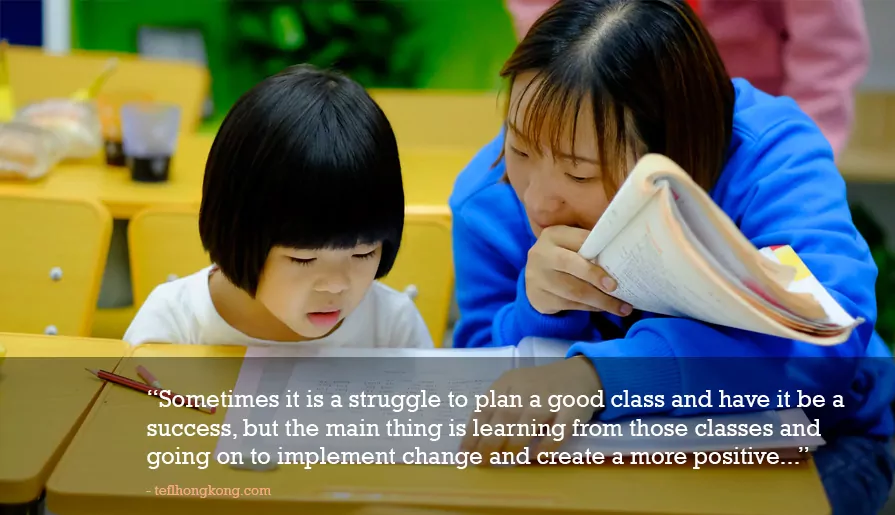
- By: Anna McIver
- In: Teaching Kids
As someone who trained in the UK secondary school system to teach students aged 12-19, my first ESL Movers class of 9-11 years old was a bit of a surprise! Ten tiny people in a classroom with seemingly endless amounts of energy and very little English can make for a reasonably challenging environment!
However, after some research and chatting to colleagues and so on, I slowly became accustomed to planning suitable lessons which kept my students busy and engaged while also helping them make progress with their English skills.
“An effective teacher manages a classroom”
– Harry Wong.
So, if like me you need a bit of guidance for keeping younger learners focussed while having fun and not losing control of the classroom, here are my top tips and ideas to help you achieve it.
1. Consistency
Routine is important in every classroom, not least for young learners. Students need to know what to expect and creating routine means no surprises and consistency. For example, setting up every class with a chosen student or students to write up the day, date, year and weather is a good way to review days, numbers etc., before you begin.
If you use a behaviour system consistency is hugely important and ensures students know everyone is treated equally, leading to a calmer learning environment.
2. A warmer activity
With the more lively groups I have taught, I find that a warmer activity on a piece of paper to be the best way to start things off. For me, a game or board activity at the start causes slight chaos as students come in bit by bit and don’t know what’s going on!
For example, a puzzle, a crossword reviewing vocab, a spot the difference and activities such as these allow students to focus quietly on something meaningful to start the class. This also means that students generally aren’t distracted as everyone comes into the class (often a few minutes late or in dribs and drabs) and keeps everyone focussed before we start the class properly. Then you can do a game or energetic task as a follow-up.
“You have brains in your head. You have feet in your shoes. You can steer yourself any direction you choose.”
– Dr Seuss.
3. Movement
Depending on your teaching style, you may find it very difficult to relinquish control and allow a little chaos into the room. (I certainly found this tricky!) But getting students out of their seats not only burns some energy but also appeals to many young learners as it is a kinaesthetic approach and a move away from more traditional seated activities.
There are lots of ways to add some movement into your classroom, many which don’t require planning such as charades, Pictionary and hangman. Even simple clapping games or throwing a ball and saying a vocabulary word in the order of the alphabet can add some fun and laughter to the classroom.
Another easy task to get students moving is to stick up vocab around the room and have them walk around while music plays. When the music stops, they must stop at the closest word, read it aloud and make a sentence. There are lots of easy variants to this game, for example with sickness flashcards we played a game to review should or shouldn’t. When the music stops, the students said a sentence to link to the flashcard, for example, next to toothache ‘You shouldn’t eat so much candy’.
“Success is the sum of small efforts repeated day in and day out”
– Robert Collier.
4. Positivity
Staying positive and encouraging all students regardless of their age is important in every learning environment but even more so with young people who may feel nervous and need that extra boost.
Verbal praise is very simple to use, and you can even create your own thumbs up or smiley face sign on a stick to wave around! https://www.amazon.in/Lakeshore-Classroom-Management-Signs/dp/B009NM66C2
Here are some examples to get you thinking! Having a visual to look at often helps younger students to focus.
A smiley face board or sticker chart which is added to each class leading to a prize of 10 minutes ‘free’ time at the end of the week, month etc., has worked well in my Young Learner classrooms. There are many designs and options available to download for free online such as from https://www.freeprintablebehaviorcharts.com. Charts such as these are a great visual way of reminding students of expectations.
One thing I have found is that adding sad faces and commenting on low-level negative behaviour does not do much to encourage positive changes and upsets some students. Focussing on rewarding those who do well seems to be a more effective approach in my experience.
“Every student can learn, just not on the same day or in the same way”
– George Evans.
5. Technology
The world of technology is now at our fingertips in a way it wasn’t when I was at school or even when I did my teacher training. But today’s generation is used to phones, computer, and tablets and so on and this can be used to our advantage as teachers as long as it is controlled and purposeful. Depending on the age of your classes, some forms of technology might not be appropriate.
For those with access to cell phones, Kahoot is an amazing resource which allows students to sign in and play a game displayed by the teacher on the whiteboard or projector while choosing their answers in real-time and receiving immediate feedback. My classes love it! It is free to sign up to and has a vast selection of quizzes, and even a make your own option! Have a look and see for yourself https://kahoot.com
Another option is using video in class. Something my younger classes like is watching a short video and making a note of what they see which we review as a class. Then we play bingo as we watch the video a second time. Video has endless possibilities and lots of songs available too which help to keep energy levels high while also engaging students. One of my class’ favourite songs was from a food unit we studied https://www.youtube.com/watch?v=frN3nvhIHUk they still remember it now!
Also Read: ESL Games for Teaching Young Learners
Conclusion: So there you have it, five ideas for keeping your young learners engaged while also helping them make progress in English. If you’re struggling at the moment, don’t worry, we’ve all been there! Sometimes it is a struggle to plan a good class and have it be a success, but the main thing is learning from those classes and going on to implement change and create a more positive outcome next time.
I hope that if you use some of these ideas in your own classroom, they help to engage your students and that you enjoy using them. I’ve also written an article on helping you prepare for early A1 learners, which might be useful.
Please Share:This article was originally published on December 2, 2019 and was last updated on January 9, 2021.
Courses We Offer:

1. CertTESOL: Certificate in TESOL
A level 5, initial teacher training qualification for new and experienced teachers, enabling you to teach English anywhere in the world. The course is equivalent to Cambridge CELTA.
Learn More
Developed by our Trinity CertTESOL experts, for a comprehensive, self-paced learning experience. Earn an internationally recognized certificate and master essential teaching skills, accessible globally 24/7.
Learn More